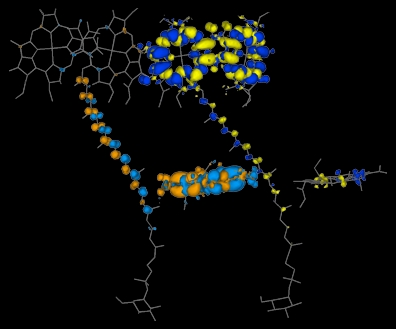

Welcome to the TDC home page, your source of information regarding the transition density cube method for calculating electronic coupling strengths between molecules.
 The
TDC method is designed to provide a highly accurate estimate of the Coulombic
portion of the electronic coupling between two molecules. As described
in more detail on the background
page, the user may utilize any quantum mechanical method to estimate the
ground and excited state wavefunctions of the molecules, which are combined
to yield a three-dimensional transition density called the transition density
cube, or TDC. TDCs of the two molecules are then interacted to give
the Coulombic coupling between them.
The
TDC method is designed to provide a highly accurate estimate of the Coulombic
portion of the electronic coupling between two molecules. As described
in more detail on the background
page, the user may utilize any quantum mechanical method to estimate the
ground and excited state wavefunctions of the molecules, which are combined
to yield a three-dimensional transition density called the transition density
cube, or TDC. TDCs of the two molecules are then interacted to give
the Coulombic coupling between them.
Because it utilizes the full three-dimensional details of the transition densities, the TDC method can determine Coulombic coupling to the fullest extent allowed by the accuracy of the original quantum mechanical calculation. For instance, the transition densities shown in the image were each calculated from a supermolecule of 3 bacteriochlorophyll and 1 carotenoid. The molecular structures are shown in gray wireframe and the densities are shown as orange and blue and yellow and blue. (See Krueger, B. P. et al. PhysChemComm 1999, 8 for more details.) These transition densities cannot be reasonably described by transition dipoles. (Click on the image for a three-dimensional VRML representation of one of the densities [5MB, not for slow connections, also IE doesn't seem to be cooperating, so use Netscape to view the VRML if you can]). Even intermediate methods, such as the monopole method, are unsatisfactory in many cases. The TDC method allows arbitrarily high accuracy, which is limited only by the graining of space in the TDC (set by the user) and the accuracy of the QM method used to estimate the molecular wavefunctions.
The Background page describes the theory behind the TDC method in a bit more detail. Usage Notes describes application of the method along with any sticky issues (e.g. the Gaussian bug). And Downloads provides the coupling program along with some handy utilities.